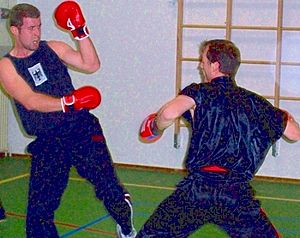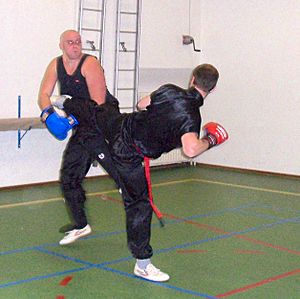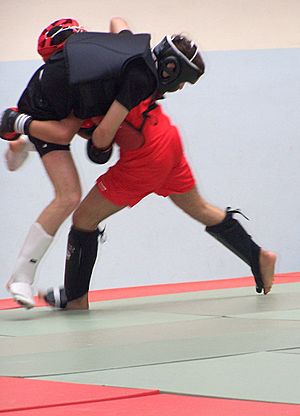Sanda (sport) facts for kids
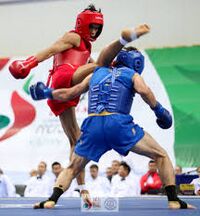 |
|
| Also known as | Sanshou, Chinese boxing, Chinese kickboxing, free combat |
|---|---|
| Focus | Hybrid |
| Hardness | Full-contact |
| Country of origin | Republic of China |
| Parenthood | Changquan, bajiquan, Northern Shaolin, shuai jiao, Chin Na, wushu, Choy Li Fut, Tai Chi, piguaquan, Kickboxing |
| Sanda | |||||||
|---|---|---|---|---|---|---|---|
| Chinese | 散打 | ||||||
| Literal meaning | free fighting | ||||||
|
|||||||
| Sanshou | |||||||
| Chinese | 散手 | ||||||
| Literal meaning | free hand | ||||||
|
|||||||
Sanda (Chinese: 散打; pinyin: Sǎndǎ), which was also known as Sanshou (Chinese: 散手; pinyin: Sǎnshǒu), is a modern Chinese martial art and combat sport. Think of it as Chinese kickboxing. The name "Sanda" means "free fighting." It was first developed by the Chinese military to create a practical fighting system.
Sanda is a mix of different fighting styles. It combines the punches of boxing with the powerful kicks of kickboxing. But it also includes wrestling moves like takedowns, throws, and sweeps. In some competitions, fighters can even use elbow and knee strikes. It's a full-contact sport, which means fighters make real contact when they strike, similar to boxing or Muay Thai.
The Chinese government helped create a standard set of rules and techniques for Sanda as a sport. This is often called Wushu Sanda. Wushu is the general term for all Chinese martial arts.
Contents
History of Sanda
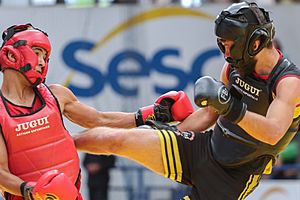
The roots of Sanda go back to ancient Chinese fighting contests. These were often held on a raised platform called a Lei Tai, and they had very few rules.
In the 1920s, the Chinese military wanted to create a modern, effective fighting style for its soldiers. They studied traditional Chinese martial arts and modern combat to create Sanda. Soldiers would often have matches to test their skills.
Later, Sanda became a civilian sport. The government created official rules to make it safer for competitions. For example, they added protective gear like gloves and headgear. The goal was to turn it into a sport that people could enjoy safely while still being exciting.
What You Learn in Sanda
Sanda training covers a wide range of fighting techniques. It is designed to be a complete system, teaching students how to fight both at a distance and up close. The main goal is to be efficient and win a match.
Because it's a sport, some of the more dangerous moves are not allowed in competitions. For example, you can't hit the back of the head, the throat, or the groin. Also, the fight is stopped if a fighter falls to the ground.
Here are some of the main techniques taught in Sanda:
Striking with Your Hands
Hand strikes are a key part of Sanda, similar to what you see in boxing.
- Jab: A quick, straight punch.
- Cross: A powerful, straight punch with the rear hand.
- Hook: A curved punch thrown from the side.
- Uppercut: A punch that travels upward to hit the chin or body.
- Back-fist: A quick strike with the back of the knuckles.
Kicking Techniques
Sanda has many different types of kicks for attacking from a distance.
- Front Kick: A straight kick forward.
- Side Kick: A powerful kick delivered with the side or heel of the foot.
- Roundhouse Kick: A circular kick that uses the hips to generate power.
- Spinning Back Kick: A surprise kick done after a quick spin.
- Sweep Kicks: Low kicks aimed at knocking an opponent off their feet.
Throws and Takedowns
What makes Sanda different from many other kickboxing sports is its use of grappling.
- Hip and Shoulder Throws: Using your body to throw an opponent, similar to judo.
- Leg Takedowns: Grabbing an opponent's legs to take them to the ground.
- Kick Catches: Catching an opponent's kick and then throwing or tripping them.
- Sweeps: Using your foot to sweep an opponent's legs from under them.
Sanda as a Sport
Sanda competitions are exciting events. They look a bit like kickboxing, but with the added action of throws and takedowns.
Fights are often held on a raised platform called a lei tai. A fighter can win by knockout, by scoring more points, or by pushing their opponent off the platform. Points are given for clean punches, kicks, and successful throws.
Fighters are only allowed to hold onto each other (clinch) for a few seconds. If they can't throw their opponent in that time, the referee separates them.
Amateur and Professional Rules
There are two main types of Sanda competitions:
- Amateur Sanda: Fighters wear protective gear, including headgear, chest protectors, and shin guards. Kicks, punches, and throws are allowed. Knee strikes are allowed to the body but not to the head. This is the most common form of Sanda seen in competitions around the world.
- Professional Sanda: This is for more experienced fighters. They wear less protective gear—usually just gloves and a mouthpiece. In professional rules, knee strikes to the head are often allowed, making it a tougher and more intense version of the sport.
Sanda in the Military
The military version of Sanda is called Junshi Sanda. It was designed for real-life combat situations. This style is not a sport and includes more dangerous techniques that are not allowed in competitions.
Junshi Sanda teaches soldiers to use any part of their body as a weapon. It includes:
- Da: Striking with hands, elbows, and even the head.
- Ti: Kicking with feet and knees.
- Shuai: Throwing and wrestling techniques.
- Chin-Na: Joint locks and submission holds to control an opponent.
World Competitions
Sanda is a global sport. The International Wushu Federation (IWUF) is the official organization for all forms of wushu, including Sanda. The IWUF organizes major international tournaments.
World Wushu Championships
This is the biggest event for wushu athletes. It has been held every two years since 1991 in different cities around the world. Both Sanda fighting and Taolu (forms) are part of the championships.
Sanda World Cup
This is another major tournament that focuses only on Sanda. It brings together the best Sanda fighters from across the globe to compete for the title of World Cup champion.
Famous Fighters
Many Sanda fighters have become famous in other combat sports, like kickboxing and Mixed Martial Arts (MMA). Their strong striking and takedown skills make them tough opponents in any ring or cage.
Some well-known fighters with a Sanda background include:
- Zhang Weili: A champion in the UFC.
- Cung Le: A former Strikeforce champion and action movie star.
- Zabit Magomedsharipov: A retired UFC fighter known for his flashy and creative fighting style.
- Muslim Salikhov: Nicknamed "King of Kung Fu," he is a multiple-time world champion in Sanda.
See also
 In Spanish: Sanda para niños
In Spanish: Sanda para niños


